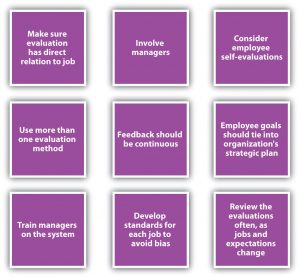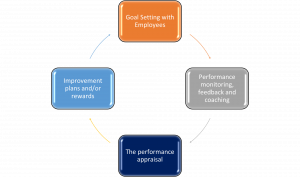12.5 Completing and Conducting the Appraisal
So far, we have discussed the necessity of providing formal employee feedback through a systematic performance evaluation system. We have stressed the importance of ensuring managers understand how often performance evaluations should be given and whether they should be tied to pay increases.
The next step is to make sure you know the goals of the performance evaluation; for example, are the goals to improve performance and also identify people for succession planning? You will then determine the source for the performance evaluation data and then create criteria and rating scales that relate directly to the employee’s job description.
Best Practices in Performance Appraisals
The most important aspects to remember when developing a performance evaluation system include the following:
-

“Best Practices in Performance Appraisal Systems” by Elizabeth Cameron CC BY-NC-SA 4.0 Make sure the evaluation has a direct relationship to the job. Consider developing specific criteria for each job based on the individual job specifications and description.
- Involve managers when developing the process. Garner their feedback to obtain “buy-in” for the process.
- Consider involving the employee in the process by asking the employee to fill out a self-evaluation.
- Use a variety of methods to rate and evaluate the employee.
- Avoid bias by standardizing performance evaluation systems for each job.
- Give feedback on performance throughout the year, not just during performance review times.
- Ensure the performance evaluation goals tie into the organizational and department goals.
- Ensure the performance appraisal criteria also ties into the goals of the organization.
- Often review the evaluation for each job title since jobs and expectations change.
The performance appraisal aspect is just one part of the entire process. We can call this a performance review system. The first step of the process is goal setting with the employee. Building out the performance appraisal criteria with the employee before the appraisal timeframe is a very effective way to communicate and set expectations – get on the same page. This could mean showing the employee his or her performance appraisal criteria or sitting down with the employee to develop management by objectives MBOs. The basic idea is that the employee should know the expectations and how his or her job performance will be rated.
Constant monitoring, feedback, and coaching are the next steps. Ensuring the employee knows what they are doing well and what is not being done well more informally will allow for a more productive employee.
Next is the formal performance evaluation process. Choosing the criteria, rating scale, and source of the evaluation are steps we have already discussed. The next step is to work with the employee to develop improvement plans (if necessary) and offer any rewards resulting from excellent performance. The process then begins again, setting new goals with the employee.

Training Managers and Employees
As Operations Managers, we know the importance of performance evaluation systems in developing employees. Managers and employees must be educated on the standards for completing performance evaluation forms, as well as how to complete the necessary documents (criteria and ratings), how to develop improvement plans when necessary, and how to deliver the performance appraisal interview.
Employee Feedback
Delivering meaningful employee feedback is essential as it provides employees with positive reinforcement in their strongest areas and coaching where there is room to improve. Please watch this YouTube video titled “The Secret to Giving Great Feedback.” This video provides Operations Managers with tips on providing feedback to employees during the performance appraisal process and beyond.
Operations Manager Toolkit
First, after you have developed the new performance appraisal system (or adjusted an old one), consider offering training on how to effectively use it. The training, if required, can later save time and make the process more valuable. What we want to avoid is making it seem as if the performance appraisal process is “just one more thing” for managers to do. Show the value of the system in your training or, better yet, involve managers in developing the process to begin with.
Set standards should be developed for managers filling out the performance ratings and criteria. The advantage of this is the accuracy of data and limiting possible bias. Consider these “ground rules” to ensure that information is similar no matter which manager is writing the evaluation:
- Use only factual information and avoid opinion or perception.
- For each section, comments should be at least two sentences in length, and examples of employee behaviour should be provided.
- Reviews must be complete and shared with the employee before the deadline.
- Make messages clear and direct.
- Focus on observable behaviours.
SMART Goals
In Operations Management, it is a good idea to train both people leaders and your employees on SMART goals. SMART stands for specific, measurable, achievable, relevant and time bound. If everyone in the organization understands how to write and measure goals, delivering performance appraisals to your staff becomes that much easier.
Operations Manager Toolkit
Here are some important steps to consider before you sit down to meet with an employee to deliver their performance review:
- Review the employee’s last performance evaluation. Note goals from the previous evaluation period.
- Review the employee’s file and speak with other managers who interface with this person. In other words, gather data about performance.
- Fill out the necessary forms for this employee’s appraisal. Note which areas you want to address with the employee in the appraisal interview.
- If your organization bases pay increases on the performance evaluation, know the pay increase you are able to offer the employee.
- Write any improvement plans as necessary.
Most people feel nervous about giving and receiving performance evaluations. One way to limit this is to show the employee the written evaluation before the interview so the employee knows what to expect. To keep it a two-way conversation, many organizations have the employee fill out the same evaluation, and answers from the employee and manager are compared and discussed in the interview. When the manager meets with the employee to discuss the performance evaluation, the manager should be clear, direct, and to the point about strengths and weaknesses. The manager should also discuss goals for the upcoming period, as well as any pay increases or improvement plans as a result of the evaluation. The manager should also be prepared for questions, concerns, and reasons for the employee not being able to meet performance standards.
Performance Improvement Plans (PIP)
Performance improvement plans are written documents defining areas for improvement. They should not be punitive, rather the goal of an improvement plan should be to help the employee succeed. Coaching and development should occur throughout the employee’s tenure. The employee should know before the performance evaluation whether expectations are or are not being met. This way, the introduction of an improvement plan is not a surprise. There are six main components to an employee improvement plan:
- Define the problem.
- Discuss the behaviours that should be modified, based on the problem.
- List specific strategies to modify the behaviour.
- Develop long- and short-term goals.
- Define a reasonable time line for improvements.
- Schedule “check-in” dates to discuss the improvement plan.
An employee improvement plan works best if it is written with the employee to obtain maximum buy-in.
“Completing and Conducting the Appraisal” in Human Resources Management – 2nd Ontario Edition by Elizabeth Cameron is licensed under a Creative Commons Attribution-NonCommercial-ShareAlike 4.0 International License, except where otherwise noted.


